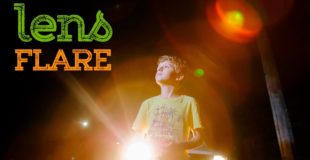Lens flare – a look at what it is, plus tips on how to harness it to add dazzle to our photography. These include the best sunlight conditions, different lenses, focus, exposure and adjusting a washed-out image.
In this clip, we’re asking what is lens flare and how can we apply it to add a creative sparkle to our photography.
Lens flare is the effect you get when strong light shines directly into the camera lens. As I’m sure you know, a lens is made up of numerous glass elements. Normally, when shooting, light will flow through the elements, one by one, before hitting the sensor or film. But powerful direct light will reflect between the elements – effectively bouncing around like a pinball – before burning an image on the sensor or film.
Lens flare can take different forms depending on the strength and shape of the light and the lens you are using.
You’ll find washed out, or ‘vieling flare’ that will cover much of your image; rings, streaks, hexagon or similar-shaped blobs of light, and – my favourite – starbursts.
Lens flare isn’t necessarily good or bad. It can look fantastic, really adding dynamism to an image, or it can simply mess up an otherwise pleasing image. Or like here, it can just be a bit unnecessary.
Bokeh, is similar to lens flare, but a little different. Bokeh is caused when highlights in an image are blurred or out of focus. It’s a nice effect and works best with a very wide, open aperture.
So here are some tips on how to experiment with lens flare:
‘Golden’ hours. It’s no secret that early morning and late afternoon are the best times to take photos. That’s especially true when using the sun to create lens flare. In the middle of the day, the sun is generally in the wrong place – too directly above – and too bright. Remember – looking directly at the sun, even through a viewfinder is really bad for your eyes.
When the sun is lower in the sky, it’s diffused through thicker atmospheric layers, making it less blinding and also a warmer, more golden colour. Conveniently for photographers, the sun is then also well positioned to make silhouettes. And lens flare works beautifully with silhouettes.
Manual focus. Shooting into the light confuses the auto-focus on your camera. It’s best therefore to duck into shadow, focus on your subject using auto-focus, switch to manual focus (all the while maintaining the same distance between camera and subject) and then shooting.
Manual exposure. Similarly shooting into the light confuses the auto-exposure on your camera. It will try to ‘average-out’ the exposure of the shot, when in fact you often want to keep the shadows nice and dark.
Personally I find lens flare works best shooting with a wide-angle lens. That way the lens flare doesn’t dominate the shot but becomes one feature in a larger picture.
It’s also when you can get the most dramatic results. For crazy lens blur use a lens with a really round front element. These images were shot at 16mm with my 16-35mm lens. You can actually see the roundness of the front of the lens in the lens blur.
5. The smaller the light source shining into the camera, the more defined the light flare. If you want to create starbursts, try obscuring part of the sun behind your subject. Moving the camera just an inch or two in any direction will change the shape of the light and therefore the lens flare.
6. Generally a zoom lens will create a broader more blurry lens flare and a fixed or prime lens will create a more defined one. This is because there tend to be fewer elements in a fixed lens than a zoom and therefore less opportunity for the light to bounce around.
7. Vieling flare produces quite a pale, washed out look. I generally find it necessary to really boost shadows in post-production (Lightroom or Photoshop) to give the image some definition.
My final tip is: take lots of shots. Lens flare is not an exact science. You’ll probably find most of your shots don’t work but you may also get a few corkers too. And the remember the fun is in the experimentation.
So good luck and happy shooting!
Original source

2 responses to “Lens flare – DSRL photography tutorial”
Great one
Awesome video and thanks for the tips!